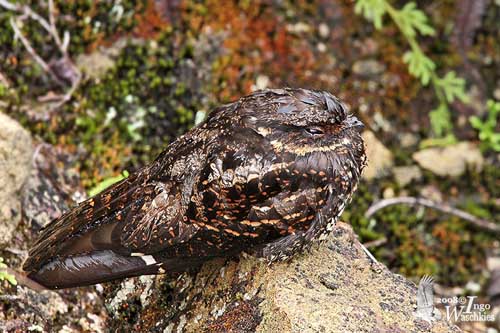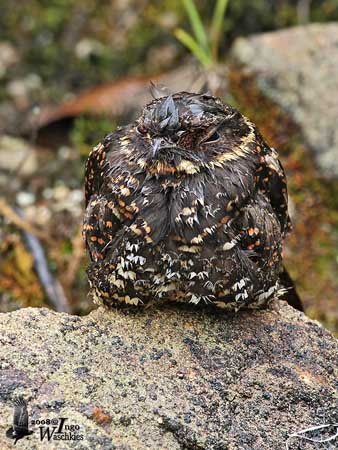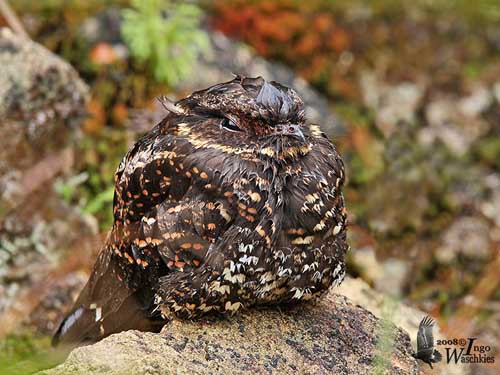
Fr: Engoulevent satanique
All: Teufelsnachtschwalbe
Esp: Chotacabras Diabólico
Ital: Succiacapre diabolico
Nd: Duivelsnachtzwaluw
Sd: Djävulsöronnattskärra
Photographer:
Ingo Waschkies
Bird Photography
Text by Nicole Bouglouan
Sources:
HANDBOOK OF THE BIRDS OF THE WORLD Vol 16 by Josep del Hoyo- Andrew Elliot-David Christie – Lynx Edicions – ISBN: 9788496553781
L’ENCYCLOPEDIE MONDIALE DES OISEAUX - Dr Christopher M. Perrins - BORDAS - ISBN: 2040185607
BirdLife International (BirdLife International)
J. Berton C. Harris - News on migration timing in Asian birds
Wikipedia, the free encyclopaedia
Satanic Nightjar
Eurostopodus diabolicus
Caprimulgiforme Order – Caprimulgidae Family
INTRODUCTION:
The Satanic Nightjar was discovered first in 1931 in N Sulawesi. Rediscovered in 1996 in C Sulawesi, this species is still poorly known.
The name of the bird refers to local superstition, and is related to its “plip-plop” nocturnal calls.
DESCRIPTION OF THE BIRD:
Biometrics:
Length: 26-27 cm
The adult male has dark cryptic plumage overall. The upperparts are greyish-brown, with brown, buff and pale tawny speckles and spots. On the head, the crown is streaked blackish, but this nightjar lacks the nuchal collar. Scapulars and upperwing-coverts are brown, with cinnamon markings.
The male shows white band around the throat. The underparts are brown with pale buff to cinnamon bars and spots. Belly and flanks are paler, mostly pale buff with brown bars. The tail shows narrow buffish tip.
The bill is blackish. The eyes are dark brown. Legs and feet are dark brown too.
The female has similar plumage, but differs by small white spots on third and fourth outermost primaries, and she has rich buff band around the throat instead white.

RANGE:
The Satanic Nightjar is endemic to the large island of Sulawesi, Indonesia.
HABITAT:
The Satanic Nightjar frequents clearings and opening in montane forest, including edges and tracks. It has been reported from several lowland sites, and from lowland hill forest and montane forest, and areas with scattered trees. This species can be seen between 250 and 1735 metres of elevation.
CALLS AND SONGS: SOUNDS BY XENO-CANTO
The Satanic Nightjar’s calls include a nocturnal wet “plip-plop” repeated twice, and a short, bubbling trill “twik-twik-twik”. In flight, it may give weak screams, loud “whirrip” and soft churrs.
BEHAVIOUR IN THE WILD:
The Satanic Nightjar forages while flying and feeds on flying nocturnal insects, captured and swallowed in flight. It hunts along forest edges, roads and tracks.

The breeding behaviour is unknown, but usually, nightjars are territorial. They are monogamous, with long-term pair-bonds, often for life.
The male establishes the territory by “singing” from the boundaries of its area, and defends it strongly against other males. They sing loudly and adopt aggressive postures with dropped wings and fanned tail. Some fights may occur sometimes.
The courtship displays are unknown too. They are probably aerial, and the male produces peculiar sounds with the wings. This behaviour needs more information.
The Satanic Nightjar is probably resident in its range.
Nightjars are very good fliers, thanks to their long, slender wings. They are agile in flight, especially while hunting or during displays.

REPRODUCTION OF THIS SPECIES:
From an observation in Central Sulawesi, a nest was found in October 2009 along a track, in a forest clearing with ferns. It was a shallow depression on the ground, made with dead fern fronds and dark moss. The area around the nest was covered with dead vegetation such as moss, leaves and plant stems.
The female usually lays a single creamy-white egg with light markings, but sometimes, there is a second egg. The incubation in Caprimulgidae ranges between 16 and 20 days.
The chick is much paler and less marked than adults. It is covered with pale buff down. It fledges about 15-20 days after hatching.
The adults may engage in threat displays when disturbed at nest. The bird opens the bill widely, in order to display the bright pink gape. If the intruder approaches too close, the sitting bird flushes and hovers briefly, always opening and closing the bill. The adult may also fly back and forth. Then, it rests on the ground with the wings partially opened, in the close vicinity of the nest.
PROTECTION / THREATS / STATUS:
The Satanic Nightjar is threatened by fragmentation and deforestation at lower elevation for agriculture. Due to the small population (2500/9999 mature individuals), this species is treated as Vulnerable.